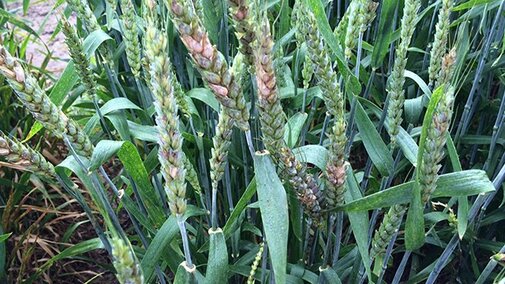A national USDA survey, published recently in Plant Disease, provides the first large-scale, systematic insight into how wheat and barley growers manage Fusarium head blight (FHB), also known as scab, and where they get information on how to control this destructive disease.
State FHB Impact
Stephen Wegulo
Extension Plant Pathologist
In Nebraska, Fusarium head blight (FHB, scab) occurs on wheat sporadically, but it can be devastating when it does. The most FHB-prone regions in Nebraska are the southeast, south central, and southwest. Major, widespread epidemics during the last 15 years occurred in 2007, 2008, 2015, and 2019.
The most important predisposing factor is excessive and frequent rainfall before and during flowering. Yield loss results mainly from sterility of infected spikelets on the head and reduction in kernel size. In addition, grain quality is reduced due to presence in the grain of the mycotoxin deoxynivalenol (DON, vomitoxin) and the presence of shriveled, discolored kernels known as Fusarium-damaged kernels (FDK) or “tombstones” that are unsuitable for milling, baking, and malting.
In years with severe epidemics, yield loss in individual fields typically ranges from 20% to 50%, but can be 100% in seed production fields or if the vomitoxin level is so high that elevators cannot accept the grain. Statewide losses in 2008 were estimated at $13.3 million. Losses in 2015 were even greater because the disease was more severe and widespread compared to 2007 and 2008.
Management strategies for FHB include the use of moderately resistant varieties, application of a triazole or an Succinate Dehydrogenase Inhibitor (SDHI) fungicide at flowering, and rotation with a non-host crop such as soybean.
FHB can reduce a farmer's yield and affect quality, lowering the price of the grain. Also, the Fusarium fungus produces a mycotoxin called deoxynivalenol or DON. Wheat with DON levels above 2 parts per million is unacceptable for human consumption. FHB also can wreak havoc with barley crops, as maltsters have a near-zero tolerance for Fusarium.
The survey, funded by the USDA Agricultural Research Service (ARS)-led U.S. Wheat and Barley Scab Initiative includes data from more than 5,100 wheat and barley growers in 17 states. It details how grain producers perceive FHB, where they get their information, which management tools they use, and problems managing the disease.
Fusarium has a wide host range, said Christina Cowger, small grains pathologist with ARS Plant Science Research Unit in Raleigh, North Carolina. "Think of it as an omnivore in the sense that it doesn't specialize just on one crop, but rather it is a pathogen of wheat, barley, oats, corn—any grain crop. It can infect a lot of plant species and consequently, build up a lot of fungus in the environment."
Weather is the main variable in determining an FHB epidemic. Once a crop is harvested, Fusarium rests in the field's debris. When a new small-grain crop is planted, and if rain occurs two weeks before plants flower, the fungus releases its spores, which land on the new crop's flowering heads and cause infection.
Techniques for minimizing FHB in wheat and barley are well established and available, Cowger said. They include using moderately FHB-resistant cultivars, monitoring of weather-driven risk, and timely use of the most effective fungicides, called demethylation inhibitors (DMIs) or triazoles.
The survey showed that farmers in the Upper Midwest use FHB-resistant varieties to a much greater extent than growers in the eastern U.S., who have still not widely adopted them. FHB first emerged as a serious problem in the upper Midwest—North Dakota and Minnesota—where it caused major damage in the 90s. In the last 20 years, it has spread throughout the eastern wheat-producing region, occurring in Georgia, New York, Kentucky and other soft wheat states.
Surprisingly, most respondents said they had not had a problem with FHB either due to the toxin or to reduced yield in the five years prior to this survey, Cowger said. Even though there is a significant and economically damaging epidemic somewhere in the United States every year, causing huge headaches for end-users of grain, it's not happening everywhere every year. This makes FHB management a special challenge: routine planting of FHB-resistant varieties is the single best protective measure, yet the disease tends to slide off growers' radar if it hasn't struck recently.
Another important finding was that farmers get disease and management information from two top sources—crop advisors/private consultants and Extension agents. Since the survey, steps have already been taken by the USDA-ARS Wheat and Barley Scab Initiative to ensure crop advisors are receiving the latest and best research information on FHB management.

